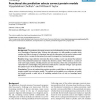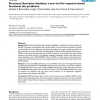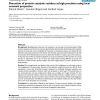BMCBI
2008
13 years 5 months ago
2008
: The tumour suppressor protein p53 protein has a core domain that binds DNA and is the site for most oncogenic mutations. This domain is quite unstable compared to its homologs p...
BMCBI
2008
13 years 5 months ago
2008
Background: The prediction of protein structure can be facilitated by the use of constraints based on a knowledge of functional sites. Without this information it is still possibl...
BMCBI
2008
13 years 5 months ago
2008
Background: Protein structure prediction methods provide accurate results when a homologous protein is predicted, while poorer predictions are obtained in the absence of homologou...
BMCBI
2008
13 years 5 months ago
2008
Background: Since experimental determination of protein folding pathways remains difficult, computational techniques are often used to simulate protein folding. Most current techn...
BMCBI
2008
13 years 5 months ago
2008
Background: A multiple sequence alignment (MSA) generated for a protein can be used to characterise residues by means of a statistical analysis of single columns. In addition to t...
BMCBI
2008
13 years 5 months ago
2008
Background: It has been previously shown that palindromic sequences are frequently observed in proteins. However, our knowledge about their evolutionary origin and their possible ...
BMCBI
2008
13 years 5 months ago
2008
Background: We present a novel method of protein fold decoy discrimination using machine learning, more specifically using neural networks. Here, decoy discrimination is represent...
BMCBI
2008
13 years 5 months ago
2008
Background: The Structural Descriptor Database (SDDB) is a web-based tool that predicts the function of proteins and functional site positions based on the structural properties o...
BMCBI
2008
13 years 5 months ago
2008
Background: Identifying the active site of an enzyme is a crucial step in functional studies. While protein sequences and structures can be experimentally characterized, determini...
BMCBI
2008
13 years 5 months ago
2008
Background: Subcellular localization information is one of the key features to protein function research. Locating to a specific subcellular compartment is essential for a protein...






